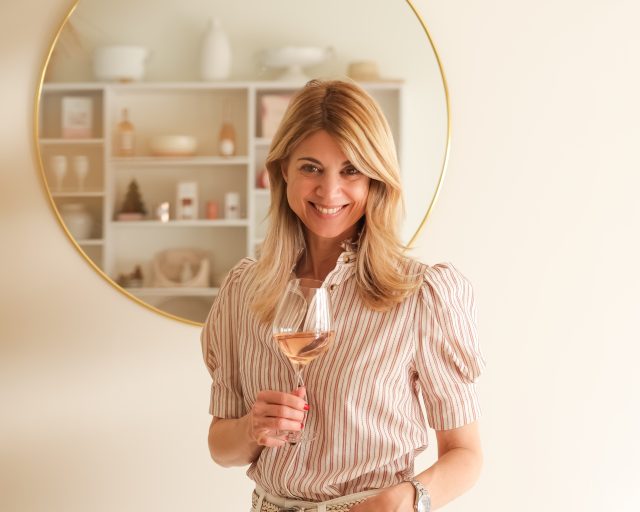Master Winemakers Top 100: Jeany Cronk
Jeany Cronk, founder of Maison Mirabeau, features as one of our top 100 winemakers and winner of the Best Design & Packaging award. She speaks to db about balancing sustainability and high-end design, dealing with smoke damage and her favourite G&T garnish.

Born in Munich, educated in the UK and with a degree in Economics & International Relations, Jeany Cronk met her husband Stephen while she was pursuing a career in tech marketing. After taking time out to look after their three young children, she started to retrain in interior design before following her husband to Provence to help him realise his winemaking dream with the creation of Maison Mirabeau.
In addition to helping to create the brand’s cuvées, Cronk lends her design skills to Mirabeau’s distinctive wine and gin bottles. She spends her spare time cooking, entertaining friends and taking the family Jack Russell Oscar on long walks in the Provençal countryside.
Her Maison Mirabeau Pure 2022 won a Master medal at the Global Wine Design & Packaging Masters 2023.
Describe your winemaking approach in no more than three words.
Focused. Creative. Detail-obsessed.
What’s your favourite part of the job?
Without a doubt the assemblage, or blending. It’s fascinating to see how the right blend can reveal a whole new personality in a cuvée. Since our cuvées each have a very specific signature, it’s a huge job to find the elements that make it special year on year. But when you have found the right elements to make the magic, it’s a great feeling.
Which aspect of the job keeps you awake at night?
As part of a family business, there would be a lot of them. But mostly it would be helping nature cope in today’s environmental circumstances and ensuring that we keep the customer at the front and centre of our thinking.

What’s your go-to drink at the end of a long day?
Since we work and live in Provence, we do actually love a chilled glass of rosé. A nice G&T with plenty of ice, a slice of grapefruit and rosemary from the garden also hits the post-work spot pretty neatly.
What’s the best piece of advice you’ve ever been given?
I’ve no idea if it’s true, but someone once said to me that 10 iterations of a piece of work will make it 1,000 times better. I certainly know re-working something a few times often improves it by a lot, so I never really accept my first attempt at anything.
What was your greatest winemaking mistake?
Trying to vinify wine with smoke damage, against all good advice. The result was one of the most unpleasant sensorial experiences of all time, only fit for the distillery.
What’s the most important winemaking lesson you’ve learned so far?
Unless you can make wine for your pleasure only, know your customer and make something they will love.
Which figure outside the world of wine inspires you?
I never thought I’d say this, but Bill Gates for all his incredibly well-targeted philanthropic initiatives.
Where would your fantasy vineyard be?
In Hyde Park.
If you weren’t a winemaker, what would you be doing and why?
I’d be a designer (which I am a lot of the year). I’d have to decide between interior and product, which would be tough, but I love all things visual and decorative. I have designed two award-winning bottles from scratch in the last three years and this has been a hugely rewarding experience for me personally and has really lifted our brand presence.
What’s the most memorable food match you’ve had with one of your wines?
The freshest whole grilled sea bass eaten on the beach.
What role does sustainability have to play in a Master-winning wine?
It’s of growing importance and relevance to the consumer. We have recently certified as a B-Corp and have numerous projects to improve our environmental footprint and awareness. There are areas that will need a lot more work and we will need to put pressure on our supply chain to work in a different way and reconsider their own energy use, especially in the glass and transport industry. At the same time, we need to produce exquisite products that are occasion-led, so the right appearance remains important to our audience. We farm regeneratively and are hoping to see these methods gain ground in our region. We would be able to neutralise a lot of our downstream impact if we farmed in a carbon-capturing way.
Which type of wine do you drink most regularly?
All kinds of rosé.

Your home is on fire: which bottle do you save?
We did have our domaine on fire a few years ago, and I saved only my dog. I’d take our Cuvée La Réserve 2022 as it was our first regeneratively farmed vintage, and a bottle of Philipponnat Clos des Goisses 2013 Champagne.
What are your top three markets and importers?
UK (direct sales)
USA (Winebow)
Australia (Oatley & Pinnacle)
And which market would you most like to enter?
Brazil
Related news
The 'family spirit' behind Champagne Gardet's 130th anniversary
Will white wine be central to Burgundy's future success in Asia?
How to make top blanc de blancs in 'the kingdom of Pinot Noir'
